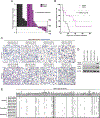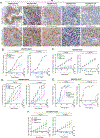Anti-tumor activity of trastuzumab deruxtecan in pediatric solid tumors with variable HER2 expression
- PMID: 40911899
- PMCID: PMC12490493
- DOI: 10.1158/1535-7163.MCT-25-0437
Anti-tumor activity of trastuzumab deruxtecan in pediatric solid tumors with variable HER2 expression
Abstract
Trastuzumab deruxtecan (T-DXd) is a HER2-targeting antibody-drug conjugate (ADC) with efficacy across adult cancers exhibiting variable HER2 expression. Prior studies demonstrating HER2 expression in osteosarcoma (OS) motivated a clinical trial of T-DXd in pediatric and adolescent/young adults with OS but was terminated early for inactivity. We evaluated the activity of T-DXd using OS patient-derived xenograft (PDX) models and found a 22% objective response rate despite no detectable HER2 expression across PDXs tested. To further assess non-HER2 mediated activity, we evaluated the activity of T-DXd across 31 pediatric cancer cell lines and found OS to be amongst the most resistant to T-DXd, as well as unconjugated deruxtecan, providing a potential explanation for the negative results observed in the clinical trial of T-DXd in OS. T-DXd evaluation in PDX models representing pediatric histologies with greater intrinsic sensitivity to deruxtecan, including pediatric renal tumors and desmoplastic small round cell tumor (DSRCT), revealed both HER2-enhanced activity, as well as substantial non-HER2 mediated activity as evidenced by equipotent activity using an isotype-matched control ADC. Together, these results underscore translational opportunities for ADC therapeutics in tumor histologies with high sensitivity to the payload, and where enhanced tumor delivery may be mediated by antibody-targeted mechanisms as well as macromolecular characteristics of ADCs (e.g., enhanced permeability and retention effect) and tumor microenvironmental factors (e.g., proteolytic payload release). Our findings challenge the role of HER2 as a biomarker predictive of T-DXd response in pediatric cancers and support further biomarker-agnostic clinical development of T-DXd in DSRCT and pediatric renal tumors. .
Conflict of interest statement
Figures



References
-
- Ogitani Y, Hagihara K, Oitate M, Naito H, Agatsuma T. Bystander killing effect of DS-8201a, a novel anti-human epidermal growth factor receptor 2 antibody-drug conjugate, in tumors with human epidermal growth factor receptor 2 heterogeneity. Cancer Sci 2016;107(7):1039–46 doi 10.1111/cas.12966. - DOI - PMC - PubMed
Grants and funding
LinkOut - more resources
Full Text Sources
Research Materials
Miscellaneous

